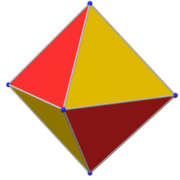|
Catalan solid  The Catalan solids are the dual polyhedron of Archimedean solids, a set of thirteen polyhedrons with highly symmetric forms semiregular polyhedrons in which two or more polygonal of their faces are met at a vertex.[1] A polyhedron can have a dual by corresponding vertices to the faces of the other polyhedron, and the edges between pairs of vertices of one correspond to the edges between pairs of faces of the other.[2] One way to construct the Catalan solids is by using the method of Dorman Luke construction.[3] These solids are face-transitive or isohedral because their faces are transitive to one another, but they are not vertex-transitive because their vertices are not transitive to one another. Their dual, the Archimedean solids, are vertex-transitive but not face-transitive. Each has constant dihedral angles, meaning the angle between any two adjacent faces is the same.[1] Additionally, both Catalan solids rhombic dodecahedron and rhombic triacontahedron are edge-transitive, meaning there is an isometry between any two edges preserving the symmetry of the whole.[citation needed] These solids were also already discovered by Johannes Kepler during the study of zonohedrons, until Eugene Catalan first completed the list of the thirteen solids in 1865.[4] The pentagonal icositetrahedron and the pentagonal hexecontahedron are chiral because they are dual to the snub cube and snub dodecahedron respectively, which are chiral; that is, these two solids are not their own mirror images. Eleven of the thirteen Catalan solids are known to have the Rupert property (a copy of the same solid can be passed through a hole in the solid).[5]
ReferencesFootnotes
Works cited
External linksWikimedia Commons has media related to Catalan solids.
|




























































